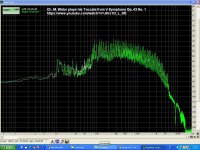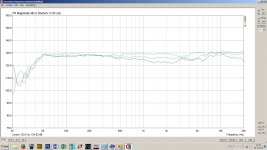Exactement.By time aligning two drivers we try to avoid the time step change between the two units (*). With perfectly aligned drive units and excluding the cross-over implications (say, reaching the case of a single full range unit), the phase does slope across the band and it’s not very linear, consequently phase delay is not constant.
This said, we do our best with the poor transducers we have ;-)
It is interesting to hear the differences in transients reproduction (drums) when when change the distance from the listener of the medium or tweeter...
...As long as the there is no significant change in levels of basses due to the nodes of the room when you change the localization of the sub(s), i agree totally.For subwoofers crossing low at 40Hz this time step is approached at spatial displacement difference of ~2.2m between sub/listener and woofer/listener. I’ve experimented with up to double that distance but I can not hear a bad effect.
coming full circle on the infrasonics. A good Cathedral will have between 5 and 8 seconds echo. lots of infrasonics there. Unless you can go deep you will never reproduce the effect of being in a space that large. I have only heard it done well once and that was a carefully 'steered' demo by Dave Wilson using Watt/Puppy and WHOW with recordings from his mates at lucasfilm. The organ appeared some 40 ft behind the front wall of the room. Getting that effect of 5 sides of the listening room vanishing is very challenging in the average domestic setting, but is a fine goal for real hifi.
Concert promoters would love to see you in the audience, marce - always the happy customer!
In fact, I have some pretty lousy experiences at shows with sound reinforcement in poor shape; when done well it makes for a memorable time, and when off it becomes excrutiating, a dentist's chair episode - I'm paying good money for this crap ... ?!!!
Er it was my usual cynical reply to your post Frank
I can tell you it was quite a sufficiency of level.
Most popular music concerts are deafening, and I avoid them. The playback volume that many like at home
is also way too loud for me, mainly because of distortion or excess bass. My home system is pretty clean
at natural levels for acoustical music, and I like to listen that way, but my wife prefers background music.
Our local concert hall, built with a huge donation to the city, has a large pipe organ, but the hall sucks out
all the deep bass. I pointed this out to our conductor when he happened to be near me in the audience at a
rehearsal, and he seemed mystified. http://www.madisonsymphony.org/king
Last edited:
Never feel the need to go there, to each his own.
Scott
This is the same part, played by the composer himself in 1932.
https://www.youtube.com/watch?v=J8vz1D_L_OE
Less extreme LF content, more rigid sound and IMO the interpretation is special.
Organ of St. Sulpice
George
Attachments
everyone else plays much faster than Vidor. Vidor understood how the accoustics worked. I have a direct to disk of Virgil Fox showing off and playing it at hyper speed. Amazing finger work, but not as the author intended.
And yes I walked down the isle to this piece. Its good enough for royalty, its good enough for me.
And yes I walked down the isle to this piece. Its good enough for royalty, its good enough for me.
I don't know if there is a consensus at this point but many seem to realize that chasing GD at low frequencies just makes little sense with a set of dynamic drivers. As Christophe has noted above about 1Khz things are different and we can pick up on this phenomena, lower in the scale in a room not something to worry about.
At the crossover points you need to get the phase and radiation pattern correct or you can easily pick up on the discontinuity there, just move around a bit and the changes are evident, you know something doesn't sound right. The more devices we have dividing the frequencies as we go up in frequency the more critical it becomes.
Another problem comes into play when we use a topology of a MTM or WMTMW arrangement, now we have introduced strong comb filter effects, the vertical changes become more and more evident and now you not only have the problem of matching radiation patterns in the horizontal axis now you are messing with the vertical axis. The proverbial head in a vise situation where the listening position becomes much more critical.
Even physically lining up all the voicecoils in a vertical line does not guarantee that you will have perfect alignment, each device has it own GD and radiation pattern and the best we can do is get the alignment correct at each crossover point. Add in the phase shift from passive crossovers and higher order crossovers and this becomes a very complex problem.
Electronic crossovers and now dsp have help greatly but I don't think there is any perfect solution for all these disparate problems of integrating multiple drivers in a speaker.
ps. We haven't even talked about the delay or smearing caused by the radiation patterns coming off the different surfaces of the enclosure, add that into your look at GD and this is just a mess.
At the crossover points you need to get the phase and radiation pattern correct or you can easily pick up on the discontinuity there, just move around a bit and the changes are evident, you know something doesn't sound right. The more devices we have dividing the frequencies as we go up in frequency the more critical it becomes.
Another problem comes into play when we use a topology of a MTM or WMTMW arrangement, now we have introduced strong comb filter effects, the vertical changes become more and more evident and now you not only have the problem of matching radiation patterns in the horizontal axis now you are messing with the vertical axis. The proverbial head in a vise situation where the listening position becomes much more critical.
Even physically lining up all the voicecoils in a vertical line does not guarantee that you will have perfect alignment, each device has it own GD and radiation pattern and the best we can do is get the alignment correct at each crossover point. Add in the phase shift from passive crossovers and higher order crossovers and this becomes a very complex problem.
Electronic crossovers and now dsp have help greatly but I don't think there is any perfect solution for all these disparate problems of integrating multiple drivers in a speaker.
ps. We haven't even talked about the delay or smearing caused by the radiation patterns coming off the different surfaces of the enclosure, add that into your look at GD and this is just a mess.
Last edited:
I don't know if there is a consensus at this point but many seem to realize that chasing GD at low frequencies just makes little sense with a set of dynamic drivers. ......
Another problem comes into play when we use a topology of a MTM or WMTMW arrangement, now we have introduced strong comb filter effects, the vertical changes become more and more evident and now you not only have the problem of matching radiation patterns in the horizontal axis now you are messing with the vertical axis. The proverbial head in a vise situation where the listening position becomes much more critical.
I must have failed to communicate that group delay is a nonsensical measure in the context of loudspeaker development.
Please think in terms of phase shift per octave (or, more precise, the slope angle of the phase plot, with frequency set out on a logarithmic scale).
This, of course, is separate from the question if it is worthwhile to limit this phase shift by fir filtering, which I don't think is supported by auditory research.
But, it is not all that bleak as you sketch when it comes to combfiltering etc. Below are anaechoic measurements of a loudspeaker with an MTM section, measured at 0, 15 and 30 degrees vertically. Having the right exterior shape and choosing xover frequencies and filter slopes carefully help a great deal to prevent problems of that nature.
Attachments
That is one of the reasons why i prefer horns for the upper range. The only way i know to have the same radiating surface, so the directivity, equal between the two transducers at the crossing frequency.Having the right exterior shape and choosing xover frequencies and filter slopes carefully help a great deal to prevent problems of that nature.
The reason why i prefer (acoustic) high slope for filters, to minimize the frequency range where they play together.
vacuphile,
With careful selection of device diameter and placement yes you can make an MTM design work, but I think many don't do that well.
Christophe,
I agree and have used high order filters when I have done passive networks, I could never consider a first order filter, second order do you or don't you invert the polarity of one of the drivers, and third order the phase angle has never been attractive to me. I've typically used either Butterworth or Linkwitz-R filters.
Today I would much rather work with active filters if at all possible and stay away from passive networks except for impedance correction.
With careful selection of device diameter and placement yes you can make an MTM design work, but I think many don't do that well.
Christophe,
I agree and have used high order filters when I have done passive networks, I could never consider a first order filter, second order do you or don't you invert the polarity of one of the drivers, and third order the phase angle has never been attractive to me. I've typically used either Butterworth or Linkwitz-R filters.
Today I would much rather work with active filters if at all possible and stay away from passive networks except for impedance correction.
+1.Today I would much rather work with active filters if at all possible and stay away from passive networks except for impedance correction.
Any way, new home, I need to re-voice my speakers :-(
Last edited:
Christophe,
What would you change in the network that will change the speakers at crossover that is going to give you a sound you want? Isn't it more of a room acoustics problem than a need to change the speakers themselves? To much bass now that your plaster walls have changed?
What would you change in the network that will change the speakers at crossover that is going to give you a sound you want? Isn't it more of a room acoustics problem than a need to change the speakers themselves? To much bass now that your plaster walls have changed?
I have a problem at cossover (1500Hz) between the bass speaker and the horn. The diameter of the horn is limit for my bass speaker. So, it is a matter of relative level between the two. At 0.2db all the landscape changes. My enclosure were ultra detailed with a impressive presence in the room where i voiced-them initially. Now, i found them harsh and tiring. Because the room is not dumped and too little.Christophe,
What would you change in the network that will change the speakers at crossover that is going to give you a sound you want? Isn't it more of a room acoustics problem than a need to change the speakers themselves? To much bass now that your plaster walls have changed?
Too, i had to change the suspension foam, may-be that had changed the way my bass speaker behave. I have to redo everything :-(
Last edited:
Thanks for posting the link to Bach's Toccota and Fugue in Dm.
Funny, at my sisters wedding rehearsal, I asked the organist after
everyone was finished if she would play this for me on the Church
organ. The old church has a wonderful old pipe organ. I didn't recall
the name but just told her the thing from the movie of the guy
with the mask...Phantom of the Opera. She replied the Bach piece,
told me what is was and pulled out the sheet music.
We both had fun for about 10 mins playing the intro and other
select parts...until everyone else started complaining that we
were supposed to leave.
Funny, at my sisters wedding rehearsal, I asked the organist after
everyone was finished if she would play this for me on the Church
organ. The old church has a wonderful old pipe organ. I didn't recall
the name but just told her the thing from the movie of the guy
with the mask...Phantom of the Opera. She replied the Bach piece,
told me what is was and pulled out the sheet music.
We both had fun for about 10 mins playing the intro and other
select parts...until everyone else started complaining that we
were supposed to leave.
- Status
- Not open for further replies.
- Home
- Member Areas
- The Lounge
- John Curl's Blowtorch preamplifier part II


